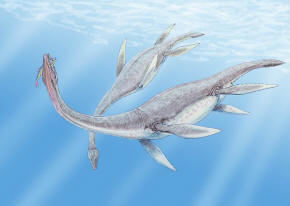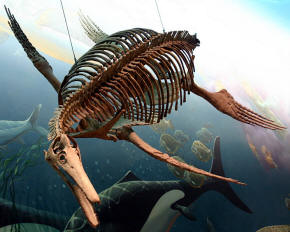|
Plesiosaurs appeared at the start of the Jurassic
Period and thrived until the K-T extinction, at the end
of the Cretaceous Period. While they were Mesozoic reptiles that lived at
the same time as dinosaurs, they were not dinosaurs.
The first
plesiosaur skeletons were found in England by
Mary
Anning, in the early 1800s, and were amongst
the first fossil vertebrates to be described by science. Many have been
found, some of them virtually complete, and new discoveries are made
frequently. One of the finest specimens was found in 2002 on the coast of
Somerset (England) by someone fishing from the shore. This specimen, called
the Collard specimen after its finder, was on display in Taunton Museum in
2007. Another, less complete skeleton was also found in 2002, in the cliffs
at Filey, Yorkshire,
England, by an amateur paleontologist. The preserved skeleton is displayed
at Rotunda Museum in Scarborough.
Many museums
have plesiosaur specimens. Notable among them is the collection of
plesiosaurs in the Natural History Museum, London, which are on display in
the marine reptiles gallery. Several historically important specimens can be
found there, including the partial skeleton from Nottinghamshire reported by
Stukely in 1719 which is the earliest written record of any marine reptile.
Other specimens include those purchased from Thomas Hawkins in the early
19th century.
Specimens are on display in museums in the UK,
including New Walk Museum, Leicester, The Yorkshire Museum, The
Sedgwick Museum in
Cambridge,
Manchester Museum,
Warwick Museum,
Bristol Museum and the
Dorset Museum. A specimen was put on display in Lincoln Museum (now
The Collection) in
2005.
Peterborough Museum
holds an excellent collection of plesiosaur material from the
Oxford Clay brick pits in the area. The most
complete known specimen of the long-necked plesiosaur
Cryptoclidus, excavated in the 1980s can be
seen there.
Plesiosaurs
had a broad body and a short
tail.
They retained their ancestral two pairs of
 |
| Restoration of a Plesiosaurus dolichodeirus pair, one
catching a fish. (Picture
Source) |
limbs, which evolved into large
flippers. Plesiosaurs
evolved from earlier, similar forms such as
pistosaurs or very early, longer-necked
pliosaurs. There are a number of
families of
plesiosaurs, which retain the same general appearance and are distinguished
by various specific details. These include the
Plesiosauridae, unspecialized types which
are limited to the
Early Jurassic period;
Cryptoclididae, (e.g.
Cryptoclidus), with a medium-long neck and
somewhat stocky build;
Elasmosauridae, with very long, inflexible
necks and tiny heads; and the
Cimoliasauridae, a poorly known group of
small Cretaceous forms. According to traditional classifications, all
plesiosaurs have a small head and long neck but, in recent classifications,
one short-necked and large-headed Cretaceous group, the
Polycotylidae, are included under the
Plesiosauroidea, rather than under the traditional Pliosauroidea. Size of
different plesiosaurs varied significantly, with an estimated length of
Trinacromerum being
three meters and
Mauisaurus growing to
twenty meters.
Unlike their
pliosaurian cousins, plesiosaurs (with the exception of the Polycotylidae)
were probably slow swimmers. It is likely that they cruised slowly below the
surface of the water, using their long flexible neck to move their head into
position to snap up unwary fish or cephalopods. Their four-flippered
swimming adaptation may have given them exceptional maneuverability, so that
they could swiftly rotate their bodies as an aid to catching prey.
Contrary to many reconstructions of plesiosaurs, it
would have been impossible for them to lift their head and long neck above
the surface, in the "swan-like"
pose that is often shown. Even if they had
been able to bend their necks upward to that degree (which they could not),
gravity would have tipped their body forward and kept most of the heavy neck
in the water.
Return to the
Old Earth Ministries Online Earth
History Curriculum homepage.
|

